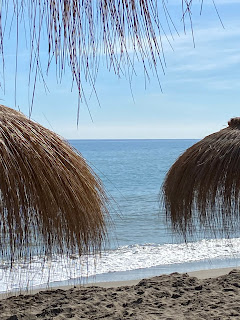Judy. I have to admit that when we left France, I wasn’t quite ready. I was becoming familiar with Vincennes and how to get around on the Metro, my French was getting better, and we were enjoying working with the Sandwich Ministry at the American Cathedral. HOWEVER, it was turning cool—the day we left it was rainy and in the fifties.
When we arrived in Málaga, a car picked us up at the airport and drove us right to our front door on a pedestrian mall, and the weather was in the eighties. This was just fine! Our apartment, although right in the middle of the touristy Old Town, is in the center of the building, so, just as in Vincennes, the noise stops as you get inside. There are lots of windows opening to the two courtyards below, and marble floors keep it cool.  |
| Our living room |
Many of you have told me that you visited Málaga either to stay or on a cruise stop, so you know how beautiful it is. We have found ourselves really settling in and just living in this beautiful place, since we almost wore ourselves out with all our little side trips in France. We have explored the city, though.
Málaga is one of the oldest continuously inhabited cities in the world, having been established as a port by the Phoenicians in about 770 BC. They called it Malaka, but when the Romans invaded in 218 BC, they called it Malaca. When the Moors invaded, they called it Mālaqua for the next 800 years, when Castille took over and named it Málaga. So the spelling has changed but the name remained the same.
 |
| First-Century Roman Theater |
A short walk from our apartment in the center of the old town are the remains of the first-century Roman Theatre. This is butted up against the well-maintained ruins of the Alcazaba, the Moorish palace next to the Castle of Gibrafaro, their fort, built in the eleventh century. It’s also a great place to get an overview of the city and the harbor.  |
| View of the Alcazaba |
 |
| From the Mirador, looking down |
 |
| Patio at the Alcazaba |
Across from our apartment is the massive Catedral de la Encarnación, with construction begun in the sixteenth century. Unfortunately, the money dried up, and the second tower was never finished, so she has gained the nickname “The One-Armed Lady”.
We attend church at St. George’s Anglican Church, in the middle of the Anglican Cemetery, established in 1831.  |
| Ted at St. George |
The beaches here really became popular in the 1950’s, and Torremolinos, a nearby town, opened the first gay bar in 1964.
The cruise stops have really put it on the map in this century, and it remains a vibrant community, as it has through the centuries.
The streets are narrow and crooked, just as they are in Cádiz, and fun to explore, unless you’re Ted trying to follow the blue dot on GPS.
 |
| Street sculpture |
 |
| We were here for the National Day of Spain |
Restaurants and bodegas are plentiful and good, and across from one of our favorite tapas places is the Picasso Museum. Since he was born here, you can also visit the Picasso Birthplace Museum.
 |
| Walk through the park to the beach |
 |
| Quiet morning at the beach |
Beaches are fifteen minutes away, as is the church. A five-minute walk in the other direction takes you to the enormous Mercado, where fresh fruits, vegetables, meats, cheese, and fish are on display at a reasonable price.
We spend lots of time there. Ten minutes further takes you to El Corte Inglés, a department store that carries anything (including food) that you could possibly want, and a few blocks past that is the Renfe train station, that can take us to visit our family in Seville.
Speaking of which, they drove the two hours to see us last week. We were supposed to have a reunion last year, but we all know how that went. There were lots and lots of hugs.
 |
| Inmita, Lucia, Alex & Alex. Fishbug Fans! (That's our grandson's band.) |
Have we done all the traveling we’d intended? Nah. But do we like it here? Just booked an apartment further down the beach for next spring.























































